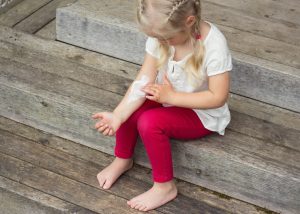It’s common for kids to get itchy rashes from time to time but, eczema in children can be particularly uncomfortable and difficult to manage.
Eczema refers to a number of conditions which cause the skin to be inflamed, red and itchy. Australia is among the countries with the highest rates of eczema, with 10% – 15% of the population affected.
It’s even more common in babies and children with a recent study suggesting 1 in 3 Australian infants suffer from eczema. Luckily, most children will grow out of atopic dermatitis as their skin matures. It’s estimated that only 10% of children with eczema or atopic dermatitis will continue to suffer into adulthood.
What is eczema?
Most people associate eczema with itchy, red patches on the skin, but many don’t know that there are actually eight different types. The most common forms of eczema to affect children include:
- Atopic dermatitis
- Contact dermatitis
- Seborrheic dermatitis (“cradle cap”)
Other forms include:
- Dyshidrotic eczema
- Hand eczema
- Lichen simplex chronicus
- Nummular eczema
- Statis dermatitis
Eczema usually appears within the first six months to five years of a child’s life and is not contagious. In babies and children eczema typically develops on the face but can appear anywhere on the body.
While the cause is still largely unknown, genetics and environmental triggers are thought to play a large role. Children with family history of atopic dermatitis, asthma or hay fever are more likely to develop atopic dermatitis.
What does eczema look like?
Eczema can effect infants, children and adults and can appear differently in children of different ages.
- 0-6 months: Appears on face, cheeks, forehead and scalp. The skin tends to look more red and “weepy”.
- 6 – 12 months: Appears on elbows and knees as they are easily scratched or rubbed during crawling.
- 2 – 5 years: Likely to appear in creases of elbows, knees, wrists, hands and ankles. It may also appear around the mouth and eyelids. The skin may look dry, scaly and thick.
- 5+ years: Usually appears in the folds of elbows and/or knees. It can also appear on the hands, behind the ears, feet or scalp.
Common triggers
- Dry skin
- Irritants
- Heat and sweating
- Infection
- Allergens: Pet dander, pollen or dust.
- Saliva: Can irritate baby’s cheeks, chin and neck.
- Weather: Dry air in winter may worsen symptoms.
How is it treated?
While there is no cure for eczema there are many treatment options that may help manage symptoms. These include over the counter medication, prescription medications and alternative therapies.
1. Identify and avoid your child’s triggers
Each child is different and their eczema may be triggered by some of the examples above or something else entirely. Keep a log of flare ups and try and eliminate exposure to any of the triggers you can identify.
2. Develop a bathing routine
Daily bathing and moisturising can help protect the skin and lock in moisture which may help sooth affected areas or reduce flare ups.
3. Prescription medication
Medication such as topical corticosteroids are usually applied twice a day to the affected areas. Only use these as prescribed by your doctor as they can vary in strength and damage the skin if they are used incorrectly. In some cases antihistamines and oral or topical antibiotic may also be prescribed.
Helpful tips
- Avoid frequent hot baths.
- Use mild soaps or non-soap cleansers instead of scented soaps.
- Pat the skin dry after a bath instead of excessive rubbing with a towel.
- Dress them in soft and breathable fabrics such as cotton.
- Apply a cool compress to the irritated areas to help ease itching.
- Keep them hydrated to help keep skin moisturised.





